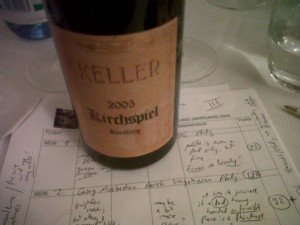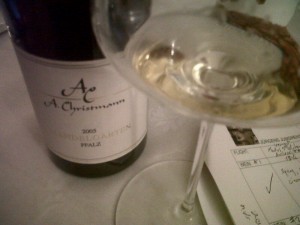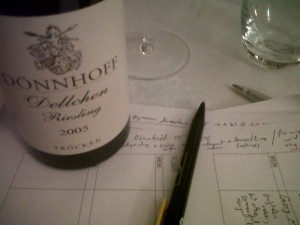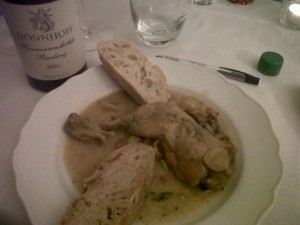Top German Rieslings from the 2005 vintage: 22 wines tasted blind
November 27, 2011
2005 struck me as a good year for some 22 top German dry Rieslings tasted in Berlin on 27 November 2011.
But also a good example to indicate the difference between fine dry Burgundy and fine dry German Riesling. Let’s face it. Dry in German can mean a bit sweet, at least for tasters like me, accustomed to most dry whites from France. Some exceptions, sure. But overall, comparing Burgundian Chardonnay with dry German Riesling – as some like to do – is rather apples and pears. Of course both are superb wines. And different. 2005, a vintage known for richness and fat, really highlights this difference. Perhaps a vintage like 2010, with more acidity, would make it less obvious?
First off, allow me to heap high praise on Jürgen Klucken for peerless organization and a terrific meal, along with extra wines for the various dishes, which included a velvety delicious home-made pumpkin soup with fresh croutons, a delectable quiche with mini asparagus, a fabulous Coq au Riesling (but of course), and a pineapple crumble with ice cream.
From A to Z, this was a great success, with friends and acquaintances in Berlin, a city I cannot praise enough: vibe, coolness, culture, easy goingness, economical, hip, etc etc…
Special thanks to my friend and fellow blogger Martin Zwick, whose notes are already up on the German wine forum: http://www.dasweinforum.de/viewtopic.php?f=98&t=1344
I stayed at the Palace Hotel, which cost €119 per night, including a superb breakfast. The comfort and attention to detail – a morning newspaper brought to the room free of charge, a welcome cake (which I did not touch), a request for a wake-up call – were all included in the most friendly manner. But that is Berlin for you: a friendly city. You make that remark to Berliners and they cannot believe it. But believe me, living in France, the difference is eindeutig. For €119, try to get the same quality in Paris.
Enough said.
The tasting had good rhythm: we started about 7 pm and ended at 1 am – lots of wine to taste, with dinner in between, and plenty of conversation and discussion. Jürgen served the wines blind in flights of two, to best compare. After tasting each pair, some discussion ensued, with the more experienced tasters guessing from which region the Rieslings may have come. Lovely glassware from Zalto Denk’Art, glasses that are very light and thin and made of crystal. I will buy some.
All 2005s… wines in bold, I liked; in red and bold even more, when underlined, the best
Flight One
Von Othegraven Kanzem Altenberg Riesling (Mosel). This showed a rather pleasing nose, a bit sweetish, some white pepper purity, with a palate that was full bodied yet a touch bitter on the finish. Turns out to be 14% alcohol, so probably not much residual sugar. 88
Van Volxem Altenberger Alte Reben (Mosel) 12%. The nose is not as expressive, even slightly closed, but the palate is very sweet and somewhat cloying on the finish. I liked this less. Dry wine? I do not think so! 86
Flight Two
A Christmann “Idig” Königsbacher (Pfalz) 13%. A nougat nose, a bit soapy to me, although there was also some chamomile elegance, I suppose. The palate displayed, again, a certain over-rich thickness which is not to my personal liking. 87
Knisper Im Grossen Garten (Pfalz) 12.5%. Funny, this wine really divided the table. Some swore by it, others found it downright faulty. I personally preferred the nose as more Riesling like, with lemon lime aspects and hints of gunflint. But, yes, there was a bit of wet sock here that detracted. Still, the palate had more acidity – even mouth puckering – and I found this the better wine. 88
Flight Three
Weingut Markus Molitar Auslese Trocken Niedermenniger Herrenberg (Mosel), 13%. This was not a grand cru, but actually was by some accounts the wine of the entire tasting. OK, it was not dry, but so beguiling. The nose alone earned justified plaudits with spice, herbs, cinnamon and even curry. A “delicious” nose preceded an exciting palate with much substance and verve, to counterbalance the 9.6 grams of residual sugar. 93+
Uhlen Heymann Löwenstein “Roth-Lay” (Mosel). Now this disappointed everyone. It was very likely a faulty bottle, displaying an overly cheesy aspect. Not rated.
With first serving of dinner: Kürbissuppe- Pumpkin soup. Here we had a delicious Heymann-Löwenstein Röttgen that did show some botrytis spice and richness, but a perfect match for the soup… certainly much better than the problematic bottle earlier.
Flight Four
Weingut Okonomiert Rebholz Kastanienbusch (Pfalz). 13.5%. Sweet licorice nose, some notes of pear, some botrytis spice. The palate is diluted but has some pleasant flavours. Nothing special here. 86
A. Christmann Gimmeldinger Mandelgarten (Pfalz) 13%. This has to be one of my favourites of the entire tasting, rivaling the Molitar. What fine pine freshness on the nose! Later it reveals a mint freshness with herbs. Very complex aromatics and flavours follow through on the somewhat delicate yet substantial palate. 93
Flight Five
Bürklin-Wolf Forster “Pechstein” (Pfalz). Apparently the village of Forst has only about 300 inhabitants. But it is known for its vineyards… Understandably with yet another lovely entry: floral notes with almost olive like aspects on the nose and palate, just very smoothly textured and agreeable. Fresh, too. 13% alcohol. 93
Georg Mosbacher Forst Ungeheurer (Pfalz). Also 13% alcohol, this wine is not quite as good but close – and very different in style. A brighter nose, but also some nougat sweetness precedes a juicy palate, although it finishes just a bit too thick. Still, there is greater intensity here. 92
Then came a delectable goat cheese quiche with Thai asparagus, almost all wanted a second helping, and I was lucky to get one J. One of the best wines of the tasting – although not tasted blind – was the Dönnhoff Dellchen (Nahe), lovely and crisp with lemon/lime freshness. This, to me, was one of the driest wines of the evening, and made me think of comparing it – for once – to white Burgundy, even Chablis. Elegant and well made. A wine to seek out, indeed. It also matched the richness of the quiche to a tee. 93+
We also had a fine Müller Catoir Breumerinden Mauern Haardter Bürgergarten. At 13.5% alcohol, this was more imposing than the Dönnhoff – and seemed to split the table. Some preferred its power, others found it wanting for grace. I liked its gun powder, tobacco and white pepper aspects and its palate texture, but given a choice, would probably also opt for the Dönnhoff. 92
Flight Six – the best flight! We reached the highlight with this flight…
Keller Kirchspiel (Rheinhessen). A beautiful nose of key lime pie, flowers and distinctly noble aromas precedes a palate that is very pure and really quite dry, but displaying nuances of orange rind, a bit of sweet grapefruit and stony mineral. The wine just got better and better in glass – and I think all of us just wanted to drink more of this than the other wines. A revelation? 95+
Wittmann Kirchspiel (Rheinhessen). The vineyards are side by side, but the styles are different. The nose is more evidently sweet, with nougat again, and also distinct notes of tobacco, which makes it intriguing – and good! The palate is also quite dry, but with a more amplified and dare I say slightly more rustic aspect than the Keller. Still, if it were not for the comparison, this wine ranks as high as the other top wines of this tasting… 93
Flight Seven
Dönnhoff Hermannshöhle (Nahe). Another wine that split the table, although there was a sense of a letdown overall. I liked the fine herbal nose, some eucalyptus that some compared to medicinal, and perhaps a hint of under-ripe vegetal? The palate was rather bright, if somewhat cloying on the finish. Overall, I got the impression of a wine that was a tad disjointed, but with time in glass, I grew to like it more. 91+
Schäfer Fröhlich Halenberg (Nahe). Subtle orange like nougat on the nose, but the palate is more like orange marmalade. There is a certain balancing freshness, but some incongruous botrytis notes detract as well. Less interesting here, but still good. 90+
Flight Eight
Georg Breuer Berg Rottland Rheingau. This wine clearly split opinions, some certain that it was corked. I thought I caught just a vague whiff of TCA, but later the wine seemed OK, as it did to others at the table. Not sure, because my tolerance for minimal TCA is generous perhaps compared to other tasters. In any case, it was a controversial bottle. For me, I liked the light apricot aspect of the nose, and a certain freshness. The palate was smooth and rather rich, but with grapefruit freshness. 90, as it did not seem faulty to me…
Emrich-Schönleber Monziger Halenberg (Nahe). Nougat and toffee on the nose but also brisk on the palate, assertive, bigger. Not as subtle as the preceding wine, however. 89+
The Coq au Riesling was perfectly prepared, with tangy skin and tender meat, matched with a fine Riesling based sauce that flavored the accompanying mushrooms and carrots and onions. Just delicious.
Flight Nine
Leitz Berg “Rottland” Alte Reben Rüdesheim (Rheingau). A dark colour and slightly oxidized. The nose was actually pleasing, with dry apricot, but veering towards oxidation. The palate was less interesting, although enjoyable through the mid palate, the finish seemed to hit a wall, with a touch of bitterness. 13.5% alcohol. 88
Georg Brauer “Nonnenberg” Monopol (Rheingau). At 13% alcohol, this wine seemed slightly faulty at first, with a bit of cheesy flavor. But time in glass helped, with notes of tobacco and freshness, although it seemed also to have a drying finish. 89?
Flight Ten
Keller Hubacker. A bit of a letdown, because it seemed so disjointed: I noted saline freshness on one level, but then all too much sweetness on another, lacking cohesion. The nose, however, seemed super promising: one of the most complex of the tasting, with ashes, citrus, apricot and melon. It just did not follow through on the palate, which left an overall impression of heat on the finish… but it could well be that this wine just needs time to come together, given the quite fascinating nose, so let’s just say 89 for now, but potential for a higher score in the years to come?
Wittmann Morstein (Rheinhessen). A clear winner here. A creamier nose, key lime pie and salt. Certainly friendlier on the palate, softer and smoother. Although not the most complex wine, it was doing its job to please the punter… Fine. 92+
We also had a lovely Suduiraut Sauternes 2001 from half bottle that needed time to open up. At first almost cloyingly sweet, but with time in glass, peppermint and black tea notes came to the fore, with a bit of cinnamon. This wine certainly needs time to lose some of that youthful baby richness… and it should reward patience. Even from a half bottle, 10 years later, this Sauternes is still far too young!






thanks for the notes. I assume the Molitor had no “trocken” on the label. you can see the vineyard here
http://www.weinlagen-info.de/#lage_id=1654
Do not think it did, but it was served blind as part of the GG tasting…
Sure, because it’s a GG-terminator
Great to find this web-site. Thanks for a good read and some good info as well. Will bookmark the page and periodically drop by. Cheers.
Many thanks for sharing valuable information about 2005 vintage wine.